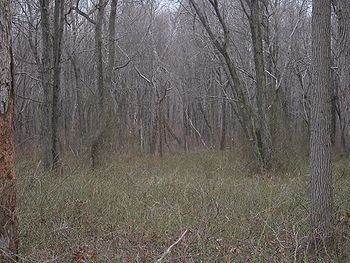
Pigeon Swamp State Park
Encyclopedia

New Jersey
New Jersey is a state in the Northeastern and Middle Atlantic regions of the United States. , its population was 8,791,894. It is bordered on the north and east by the state of New York, on the southeast and south by the Atlantic Ocean, on the west by Pennsylvania and on the southwest by Delaware...
. It is an undeveloped park, with a mix of habitats including open ponds and uplands hardwood forests. It also includes a good example of an inner coastal plain lowland deciduous
Deciduous
Deciduous means "falling off at maturity" or "tending to fall off", and is typically used in reference to trees or shrubs that lose their leaves seasonally, and to the shedding of other plant structures such as petals after flowering or fruit when ripe...
hardwood forest. At one time, it was a major nesting site for passenger pigeons before they became extinct. It was declared a National Natural Landmark
National Natural Landmark
The National Natural Landmark program recognizes and encourages the conservation of outstanding examples of the natural history of the United States. It is the only natural areas program of national scope that identifies and recognizes the best examples of biological and geological features in...
in December 1976.
The park is located in the Lawrence Brook
Lawrence Brook
Lawrence Brook is a tributary of the Raritan River. Its entire course is in Middlesex County, New Jersey in the United States.-Course:Originally a stream, its course now includes man-made lakes created by dams built in the 19th and 20th centuries: Deans Pond , Davidsons Mill Pond , Farrington Lake...
watershed.
History
The name of the park came from one of its original owners, Ann Pidgeon, daughter of Jeremiah BasseJeremiah Basse
Jeremiah Basse was a governor of both West and East Jersey. He became governor of West Jersey in 1697, and became governor of East Jersey in the following year....
. It transferred to John Wetheril in 1761. In 1780, the building of the Great Ditch
Great Ditch
The Great Ditch is a drainage ditch that drains certain areas of the Pigeon Swamp State Park.-Course:The Great Ditch starts at , in the Pigeon Swamp State Park...
was begun which attempted to drain Pigeon Swamp in order to create farmland. The ditch was maintained by the state until the mid 19th century. In 1945, the Dallenbach Sand Company dredged part of the site, near what is now I-95.. The dredged section is clearly visible from Deans Rhode Hall Road as an open area with a large lake. The entire area is fenced off.
As of February 1973, Pigeon Swamp was a 2600 acres (1,052.2 ha) unprotected wetland. In 1974, efforts began to turn it into a state park. The park comprises a large number of land plots, owned by the state of New Jersey and managed by its Department of Environmental Protection, Division of Parks and Forestry. Development continues to occur nearby, although there are attempts to preserve space for historical or environmental reasons.
Flora and fauna
Many instances of sweetgum, red mapleRed Maple
Acer rubrum , is one of the most common and widespread deciduous trees of eastern North America. It ranges from the Lake of the Woods on the border between Ontario and Minnesota, east to Newfoundland, south to near Miami, Florida, and southwest to east Texas...
, pin oak
Pin oak
Quercus palustris, the Pin oak or Swamp Spanish oak, is an oak in the red oak section Quercus sect. Lobatae.-Distribution:...
and black gum trees are visible from the road and trails. In the open meadows, Kestrel
Kestrel
The name kestrel, is given to several different members of the falcon genus, Falco. Kestrels are most easily distinguished by their typical hunting behaviour which is to hover at a height of around over open country and swoop down on prey, usually small mammals, lizards or large insects...
s and Red Tailed Hawks have been spotted. There are also vernal pool
Vernal pool
Vernal pools, also called vernal ponds or ephemeral pools, are temporary pools of water. They are usually devoid of fish, and thus allow the safe development of natal amphibian and insect species...
s which are heavily used by amphibians
Visiting
The park is mostly undeveloped land, with no facilities, other than a small parking area. Deer hunting is allowed in the park, so appropriate cautions must be taken during deer season, including wearing Blaze orange clothing.A certain area of the park is closed off to the general public. It is used as a training facility for large cranes and tractors.The area, which includes a lake, is surrounded by barbed wire fences.

